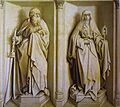Marriage of the Virgin (Campin) facts for kids
Quick facts for kids Marriage of the Virgin |
|
|---|---|
 |
|
| Artist | Robert Campin |
| Year | c. 1420–1430 |
| Medium | oil on panel |
| Dimensions | 77 cm × 88 cm (30 in × 35 in) |
| Location | Museo del Prado, Madrid |
The Marriage of the Virgin (also known as The Betrothal of the Virgin) is an oil painting created around 1420–1430 by Robert Campin. This artwork tells a story about how old beliefs and traditions changed into new ones. It uses special symbols and hidden meanings to show this idea. The painting became part of the Spanish royal collection in 1584. Today, you can see it at the Prado Museum in Madrid, Spain. This painting is one of Robert Campin's earliest works. For a while, people thought it was painted by another artist, Roger Van der Weyden.
The painting shows Mary and Joseph getting married in front of a Gothic building that isn't finished yet. In the background on the left, there's an older Romanesque building. This building shows the "Miracle of the Flowering Rod," which is how Joseph was chosen to marry Mary. The windows at the top of this building have stained glass. These windows show scenes from the Hebrew Bible, which are stories from the Old Testament. Robert Campin's main goal with this painting was to show the shift from old ways of thinking to new ones.
Contents
Who Painted It?
The Marriage of the Virgin is one of Robert Campin's first paintings. However, for some time, people believed it was painted by Roger van der Weyden. Roger van der Weyden was a student of Robert Campin from about 1410 to 1420. The back of the painting has figures of Saint Clare and Saint James the Elder. These figures were painted in a gray, statue-like style called grisaille. Because of this unique style, many thought Roger van der Weyden had created the painting.
Art Style and Details
Campin was known for working in the International Gothic style. This art style uses strong geometric shapes and bright colors in both buildings and paintings. You can see this in the painting on the right side, where an unfinished Gothic cathedral is being built. The pillars have sharp lines and pointed arches, which are typical of Gothic design. This is different from the rounded arches of the Romanesque building on the left side.
Inside the Romanesque building, three stained glass windows show scenes from the Old Testament. Campin learned to paint Romanesque buildings by looking at old frescoes (wall paintings) that had similar structures. He also used his imagination to create the detailed work you see.
The International Gothic style is also clear in the rich colors of the people's clothes. The painting also shows a lot of naturalism. This means the faces of the people look very real, and the painting accurately shows details from everyday life. The lines and surface details of the buildings and pillars are also very important in the painting. Each line on the architecture can be seen clearly. The painting was made using oil paints on an oak wood panel.
What the Symbols Mean
One important symbol in The Marriage of The Virgin is the "Miracle of the Flowering Rod." This miracle is shown in the older, domed building on the left. This building might represent the Temple of Jerusalem. In this scene, the high priest Abithar is performing a sacrifice in the Holy of Holies, which was the most sacred part of the Jewish Temple.
The main event, the marriage of Joseph and Mary, happens at the entrance of a Gothic doorway. This doorway is the only finished part of the Gothic building. The painting purposely shows a contrast between "old" and "new" architecture. The Miracle of the Rod and the marriage of Joseph and Mary happen at the same time in the painting. The Miracle of the Rod represents the old laws and traditions of Judaism. The marriage of Joseph and Mary shows the start of a new time, representing Christianity and how it differs from Judaism.
Where the Painting Has Been
This painting by Robert Campin was first taken to El Escorial in San Lorenzo. There, it became part of the royal art collection. In 1839, the painting moved to the Prado Museum in Madrid. It has been there ever since.
Images for kids
See also
 In Spanish: Desposorios de la Virgen (Robert Campin) para niños
In Spanish: Desposorios de la Virgen (Robert Campin) para niños



